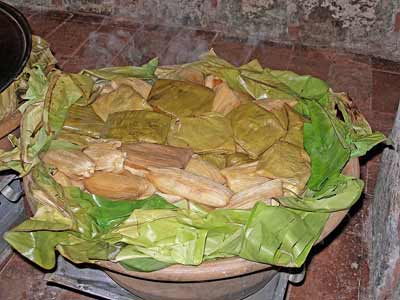A tamale is made with masa, or cornmeal dough, that
is placed in a softened corn husk or plantain leaf, and filled
with various toppings. The cook spreads the masa on the husk,
followed by a filling of beef, pork, or chilies. These ingredients involve a
significant amount of preparation. The masa is
made with cornmeal and lard and seasoned with cumin, onion, and chilies. The
meat has to be simmered until extremely tender, which usually takes several
hours. It is also seasoned with onion, chilies, cumin and other spices. Even a
chili filling is time-consuming – they must be roasted, peeled, seeded, and
chopped before being placed in the corn husk with the masa(HICA). After this, the
cook wraps up the corn husk and steams the tamale for several minutes. They can
be served immediately afterward or stored for a later time, as the husk traps the heat of the tamale.
While the tamale in its traditional form
has held its own in the Mexican culture, many, many varieties have developed
across the country – to the extent that each region has its own distinctive
version of the tamale. Fillings vary from sweet (cinnamon, raisins, fruit) to
savory (mushrooms, fish, egg, squash). Some regions use edible fruit leaves,
like those of the avocado or banana tree, or even soft tree bark (Tamara’s
Tamales). Specific variations include tamale
tomilenses of Colombia, which
contain chicken, pork belly, pork rib, boiled eggs, carrots, pea, potatoes,
rice, condiments, and masa all
wrapped into banana leaves (Tamales Tomilenses). Tamales de elote of Mexico are considered dessert
tamales in some regions because sweet corn is utilized for the masa dough. Nacatamales are a Honduran and Nicaraguan
variation on tamales. They are steamed corncakes filled with meat and
vegetables and wrapped in banana leaves, and they are classified as a ‘special
occasion’ food eaten only on Sunday mornings or during holidays, especially for
The history of tamales is somewhat
unclear – some archaeologists believe that they can be traced back to as early
as 7000 B.C. in pre-Colombian history. Mayan iconography shows plates
with round balls that resemble tamales, which likely signifies their inclusion
in Maya culture, though the word tamale comes from the Nahuatl tamali (Pilcher, 1). Fossil corn husks have
been discovered near the pyramids of the Sun and the Moon at Teotihuacan, which
would indicate the existence of tamales between 250 B.C. and 750 B.C. Aztecs,
or the Mexica people, found that they needed a more portable version of their
traditional meals, so that their army could be sustained during training or
long journeys. They quickly found that tamales could be made from the staples
of their diet, were very filling, and could be transported easily (and kept
warm) with a ‘wrapper’ of corn husk. Initially, Aztec women buried tamales in
hot ashes to cook them; they quickly moved on to underground pits or uncovered
pots for steaming (Warner).
Tamales are traditionally viewed solely
as a Mexican dish; however their portability, ingredients, and association with
tradition have linked them to many other regions. The process of making tamales
and their distinctive ingredients varies all across Central America, and has
even been adopted some extent in South America. Tamales are also very popular
further north, in the Mississippi Delta region.
The history of the tamale in the Delta
also somewhat unclear, so several theories about its origins have developed.
Some historians believe that migrant laborers brought tamales over from Mexico,
and recognizable ingredients and portability quickly made them popular among
African-American field workers. Others think that American soldiers brought
them back from the Mexican-American war; others still insist that tamales have
“always been in the Delta.” Delta tamales do differ just slightly from Mexican
tamale – they are smaller and simmered rather than steamed. Tamales have
persisted in the Delta for many of the same reasons that they have lasted in
Mexican culture – they are a warm and hearty food that could be transported to
picking fields during the harvest and then sold to the public during the
offseason (Evans).
Lexicographer: Hannah Dean, Tulane
University
Bibliography
Evans, Amy. "An
Introduction: Hot Tamales & The Mississippi Delta." Southern Foodways Alliance.
N.p., 31 Mar. 2006. Web. 07 Oct. 2013.
Pilcher, Jeffrey M. ¡Que vivan los tamales! : Food and
the Making of the Mexican Identity. Albequerque: Diálogos. 1998. Print.
Pilcher, Jeffrey M. Tamales or Timbales: Cuisine and
the Formation of Mexican National Identity. The Americas, 1996, Vol. 53 (2), pp.193-216 [Peer Reviewed Journal]
Tamara’s Tamales. A History of Tamales. N.d. Web.
07 Oct. 2013.
"Tamales Tolimenses (Tolima Region Tamales)." My Colombian Recipes RSS. N.p., n.d. Web. 05 Nov. 2013.
The Hispanic Interest
Coalition of Alabama (HICA). "Tamales." The Hispanic Interest
Coalition of Alabama, n.d. Web. 08 Oct. 2013.
Warner, Katie. "The
History Behind Tamales." The
Austin Times: A Multicultural News Source. The Austin Times, 12 Jan. 2013.
Web. 08 Oct. 2013.
Wyatt, Andrew R. "Mexico and Central America,
Precolumbian." Encyclopedia of Food and
Culture. Ed. Solomon H. Katz. Vol. 2. New York: Charles Scribner's
Sons, 2003. 497-502. Gale Virtual Reference Library.
Web. 1 Oct. 2013.

